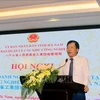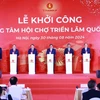The face of Vietnam’s telecommunications sector is to change with major restructuring set to attract a host of foreign investors and allow the local telcom market to finally deliver on its rich promise, the Vietnam Investment Review (VIR) reported on August 18.
Vietnam’s telecommunications sector is poised to enjoy a change in fortunes with prime ministerial Decision 888/QD-TTg .
The decision, dated June 10, 2014, approved the restructuring plan of state-owned Vietnam Post and Telecommunications Group (VNPT), which has seen its prized asset MobiFone fall under direct management of the Ministry of Information and Communications (MIC) from July 1, 2014, prior to its planned equitisation.
Decision 888 will turnaround Vietnam’s telecom industry by giving birth to the healthy co-existence of three major state-owned telecom services providers – MobiFone, Viettel and VinaPhone – which account for a 97 percent share of the local telecoms market.
The decision is designed to overhaul the market, by eradicating its monopolistic tendency and help bolster market transparency.
Decision 888 also demonstrates Vietnam’s readiness to implement its multilateral and bilateral agreements.
MobiFone needs to complete its equitisation by next year, an important timeline which marks the formation of the ASEAN Economic Community.
MobiFone’s split from VNPT could usher in huge opportunities for domestic and foreign investors determined to participate in MobiFone’s ambitious plans.
In fact, domestic and foreign investors have been tracking MobiFone’s potential restructuring for many years.
In late 2006, when the company’s shake-up plan was first revealed, about 10 global financial investment funds and banks stepped forward to act as equitisation consultants for the company. These consultancy units – which included bluechip names such as Goldman Sachs, Morgan Stanley, UBS, Credit Suisse and Deutsche Bank – would help MobiFone in asset valuation, select strategic partners and outline further equitisation steps.
Global telecom groups also expressed great interest in becoming strategic partners of MobiFone. Prestigious group have included Orange France Telecom, SingTel, Telenor, Comvik, T-Mobile and Vodafone – all having offered favourable conditions to be a partner of MobiFone.
Diverse reasons lie behind the company’s equitisation dream having yet to be realised, but not all firms have been deterred, as Orange France Telecom maintains an interest in buying a stake in MobiFone.
So, why has this state-owned mobile services operator proven so appealing to investors? Its charms are obvious to many savvy investors, as MobiFone has reported impressive performances over consecutive years.
According to Vietnam’s White Book on the Information Communications Technology, the company enjoyed a 21.4 percent market share last year ahead of state player VinaPhone (19.8 percent) and only behind military-run giant Viettel, which had the lion’s share of 40.5 percent.
Furthermore, MobiFone last year posted an eye-catching 41 trillion VND (1.95 billion USD) in revenue and 6 trillion VND (286 million USD) in profits.
This promise resulted in MobiFone’s equitisation consultancy firm Credit Suisse setting the company’s value at 2 billion USD several years ago. However, Ho Chi Minh City-based securities firm HSC now sees this valuation as inadequate.
Based on MobiFone’s former price to earnings (P/E) ratio of 12, MobiFone’s current value could be 3.4 billion USD and may surpass 4 billion USD when the company undergoes its initial public offering (IPO).
Another key factor increasing the company’s appeal in the eyes of foreign investors is MobiFone’s 10-year relationship with Comvik, a subsidiary of Sweden’s Millicom International Cellular SA, to develop the Vietnamese firm’s network.
MobiFone’s healthy partnership with Comvik bodes well for future co-operation with other investors.
Whether MobiFone will sell 49, 30 or just 20 percent stake is the question on investors’ lips.
When MobiFone’s equitisation commitment was approved by the Prime Minister in 2006, foreign investors would have been allowed to buy just 20 percent of the company.
In 2008, when the company began sourcing strategic partners, then Deputy Minister of Information and Communications Tran Duc Lai said a foreign strategic partner could hold up to a 30 percent stake in MobiFone under Vietnam’s commitments to the World Trade Organization (WTO).
At a roundtable meeting on restructuring Vietnam’s telecom market held in February this year, Head of MIC Telecommunications Department Pham Hong Hai said following Vietnam’s commitment when joining the WTO, the foreign ratio cap in infrastructure companies including telecoms may reach a threshold of 49 percent.
“In respect to timeline, VNPT’s restructuring plan will gain traction from now until 2015,” the VIR quoted Hai as saying.
MobiFone is now under the MIC’s direct management. For equitisation to become a reality, the ministry needs to submit an action plan to the Prime Minister in the third quarter of this year for implementation and completion the following year.
In a broader sense, MobiFone’s restructuring roadmap and pending equitisation are tipped to help spark greater international interest in Vietnam’s merger and acquisition (M&A) agenda and the significant opportunities on offer for investors.-VNA
Vietnam’s telecommunications sector is poised to enjoy a change in fortunes with prime ministerial Decision 888/QD-TTg .
The decision, dated June 10, 2014, approved the restructuring plan of state-owned Vietnam Post and Telecommunications Group (VNPT), which has seen its prized asset MobiFone fall under direct management of the Ministry of Information and Communications (MIC) from July 1, 2014, prior to its planned equitisation.
Decision 888 will turnaround Vietnam’s telecom industry by giving birth to the healthy co-existence of three major state-owned telecom services providers – MobiFone, Viettel and VinaPhone – which account for a 97 percent share of the local telecoms market.
The decision is designed to overhaul the market, by eradicating its monopolistic tendency and help bolster market transparency.
Decision 888 also demonstrates Vietnam’s readiness to implement its multilateral and bilateral agreements.
MobiFone needs to complete its equitisation by next year, an important timeline which marks the formation of the ASEAN Economic Community.
MobiFone’s split from VNPT could usher in huge opportunities for domestic and foreign investors determined to participate in MobiFone’s ambitious plans.
In fact, domestic and foreign investors have been tracking MobiFone’s potential restructuring for many years.
In late 2006, when the company’s shake-up plan was first revealed, about 10 global financial investment funds and banks stepped forward to act as equitisation consultants for the company. These consultancy units – which included bluechip names such as Goldman Sachs, Morgan Stanley, UBS, Credit Suisse and Deutsche Bank – would help MobiFone in asset valuation, select strategic partners and outline further equitisation steps.
Global telecom groups also expressed great interest in becoming strategic partners of MobiFone. Prestigious group have included Orange France Telecom, SingTel, Telenor, Comvik, T-Mobile and Vodafone – all having offered favourable conditions to be a partner of MobiFone.
Diverse reasons lie behind the company’s equitisation dream having yet to be realised, but not all firms have been deterred, as Orange France Telecom maintains an interest in buying a stake in MobiFone.
So, why has this state-owned mobile services operator proven so appealing to investors? Its charms are obvious to many savvy investors, as MobiFone has reported impressive performances over consecutive years.
According to Vietnam’s White Book on the Information Communications Technology, the company enjoyed a 21.4 percent market share last year ahead of state player VinaPhone (19.8 percent) and only behind military-run giant Viettel, which had the lion’s share of 40.5 percent.
Furthermore, MobiFone last year posted an eye-catching 41 trillion VND (1.95 billion USD) in revenue and 6 trillion VND (286 million USD) in profits.
This promise resulted in MobiFone’s equitisation consultancy firm Credit Suisse setting the company’s value at 2 billion USD several years ago. However, Ho Chi Minh City-based securities firm HSC now sees this valuation as inadequate.
Based on MobiFone’s former price to earnings (P/E) ratio of 12, MobiFone’s current value could be 3.4 billion USD and may surpass 4 billion USD when the company undergoes its initial public offering (IPO).
Another key factor increasing the company’s appeal in the eyes of foreign investors is MobiFone’s 10-year relationship with Comvik, a subsidiary of Sweden’s Millicom International Cellular SA, to develop the Vietnamese firm’s network.
MobiFone’s healthy partnership with Comvik bodes well for future co-operation with other investors.
Whether MobiFone will sell 49, 30 or just 20 percent stake is the question on investors’ lips.
When MobiFone’s equitisation commitment was approved by the Prime Minister in 2006, foreign investors would have been allowed to buy just 20 percent of the company.
In 2008, when the company began sourcing strategic partners, then Deputy Minister of Information and Communications Tran Duc Lai said a foreign strategic partner could hold up to a 30 percent stake in MobiFone under Vietnam’s commitments to the World Trade Organization (WTO).
At a roundtable meeting on restructuring Vietnam’s telecom market held in February this year, Head of MIC Telecommunications Department Pham Hong Hai said following Vietnam’s commitment when joining the WTO, the foreign ratio cap in infrastructure companies including telecoms may reach a threshold of 49 percent.
“In respect to timeline, VNPT’s restructuring plan will gain traction from now until 2015,” the VIR quoted Hai as saying.
MobiFone is now under the MIC’s direct management. For equitisation to become a reality, the ministry needs to submit an action plan to the Prime Minister in the third quarter of this year for implementation and completion the following year.
In a broader sense, MobiFone’s restructuring roadmap and pending equitisation are tipped to help spark greater international interest in Vietnam’s merger and acquisition (M&A) agenda and the significant opportunities on offer for investors.-VNA



















